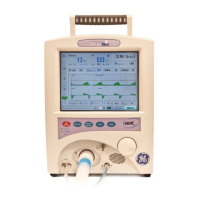2 Setting up
49
REMOTE ALARM
The iVent
TM
201 can be connected to a remote alarm system via the Remote
Alarm Connection port on the back panel shown in Figure 20.
Using Normally Opened (NO) or Normally Closed (NC) signals, this connection port
allows alarm signal activation in locations remote from the ventilator triggered by
ventilator alarm conditions. For connector details see Appendix H: Remote Alarm
Connector.
WARNING Connect the Remote Alarm Cable only to its designated port marked
accordingly.
NOTE The iVent
TM
201 is supplied with the Remote Alarm port covered (See Figure 20).
Unscrew the cover to connect the Remote Alarm cable.
The LAN port is not in use and should be covered with the plastic cap at all
times
SENSOR LINE MAINTENANCE
The iVent
TM
201 monitors the sensor lines and periodically sends pressurized air
through the lines to clear them of any accumulated material. It is possible for
secretions and/or condensation to accumulate. Should this occur:
1. Do not attempt to clean sensor lines while a patient is connected to the
iVent
TM
201.
2. Disconnect the sensor lines from the connectors on the iVent
TM
201.
3. Insert the end of a syringe into one end of the sensor line and discharge air
through it until the line is clear of condensation or secretions.
4. Re-attach the sensor lines.
PATIENT CONNECTION
When connecting the patient, make sure the Patient Wye is positioned so that the
flow sensor tube connections are on top.
Angle the Patient Wye downward to help prevent fluid accumulation.
FILTERS
WARNING Do not use the iVent
TM
201 without the air-inlet filter and a bacterial filter
before the patient circuit.

